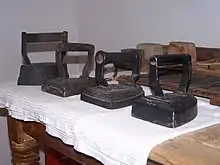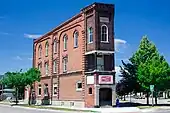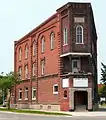I.O.O.F. Centennial BuildingFec | |
 | |
  | |
Interactive map | |
| Location | 150 E. Chisholm Street Alpena, Michigan, United States |
|---|---|
| Coordinates | 45°03′40″N 83°25′57″W / 45.06111°N 83.43250°W |
| Built | 1876; c. 1903 (addition) |
| Built by | Fred Ludwig |
| Architect | William Mirre |
| Architectural style | Late Victorian, Italianate |
| NRHP reference No. | 15000944 |
| Significant dates | |
| Added to NRHP | December 29, 2015 |
| Designated MSHS | June 15, 1979 |
The I.O.O.F. Centennial Building is an historic building located at 150 East Chisholm Street in Alpena, Michigan. It was listed on the National Register of Historic Places in 2015.[1][2][3] It dates back to 1876 and is “an excellent example of late Victorian commercial architecture.”[3][4]
History
The site was formerly occupied by the first Alpena County Courthouse,[5] destroyed by a fire on December 12, 1870,[6] and is a designated state historic site.[7] Originally known as the Centennial Block or the Hitchcock Block, the building was constructed in 1876 for Samuel E. Hitchcock and his wife, Samantha Hitchcock, two of the first settlers and most prominent citizens of the city of Alpena.[5][8] The building changed hands multiple times over the next decades, and is now owned by Mike and Kate Phillips. Following their recent acquisition, they launched their successful effort to have the structure included on the National Register of Historic Places.[2][9]
In 1901 it was sold to the local chapter of the Independent Order of Odd Fellows (I.O.O.F. Alpena Lodge No. 170) of which Samuel Hitchcock himself was a member.[10] It adopted its designation of the I.O.O.F. Centennial Building from the society. The Odd Fellows has been headquartered in the building's third story since late 1876 and occupied it until 1969, when the fraternity was forced to sell its seat due to declining membership and finances.[8] The building was occupied by several I.O.O.F. lodges: Alpena Lodge No. 170, Myrtle Lodge No. 432 (founded in 1893, and merged with the Alpena Lodge in 1926), Canton Alpena No. 31, Thunder Bay Encampment No. 87, and two Rebekah lodges, Primrose No. 364 and Beulah No. 91 (combined in 1936).[8][11] The Odd Fellows remained there for 93 years.[2] The building has also housed a variety of professionals, businesses and organizations over the course of its history, including book and music stores, the city library,[12] the Red Ribbon Society (a forerunner of the Woman's Christian Temperance Union), and a restaurant.[8][upper-alpha 1] Elizabeth C. Nason's Centennial Book Store occupied the structure's first floor from 1881 to 1899.[8]
The building has been known by at least seven names: "Hitchcock block" or "Hitchcock's block"; "Centennial building" or "Centennial block;" "Odd Fellows Hall;" "I.O.O.F. Hall;" and "Odd Fellows' Temple."[13]
Architecture

The I.O.O.F. Centennial Building stands at three floors, with a basement level, and occupies a triangular lot at the intersection of Chisholm Street, West Washington Avenue and First Avenue, within the city's central commercial district. Designed by architect William Mirre[upper-alpha 2] and built by Fred Ludwig, a local bricklayer, it is one of the oldest existing buildings in downtown Alpena, and a good example of Italianate architecture.[8] It is in the form of a flatiron building.[2][8][13] As with numerous other wedge-shaped buildings, the phrase "Flatiron" derives from its contour, and specifically its exterior resemblance to a cast iron clothes iron.[17][upper-alpha 3]
The structure stands on a "coursed ashlar dressed masonry foundation"[13] and is entirely made of brick, as required by the Alpena fire limit ordinance enacted after the blaze of July 12, 1872[8] (the largest fire in Alpena's history, which destroyed 15 acres of homes and businesses).[20] The original north and south elevations (respectively seven and five bays wide) are divided into three vertical sections, and feature rusticated piers, quoins, and ornamental hood moldings. The north façade, facing Washington Avenue, contains two ground floor storefronts and is crowned by an elaborate frieze, consisting of two long rectangular panels separated by a projecting pediment. The raised brickwork within the panels spell out 'CENTENNIAL' and '4 JULY 1876' that celebrates America's century of independence and the year the building was constructed.[upper-alpha 4]
The building was heavily remodeled by the Odd Fellows in the first decade of the twentieth century. The easternmost bay facing Chisholm Street was added circa 1903[8] and contains a recessed corner entrance on the first floor, surmounted by an open balcony and by an enclosed brick third story. The protruding addition resembles a prow, and gives the building a distinctive look. The limestone portal that leads to the recessed door features a lintel displaying 'IOOF' in raised letters; the same acronym is displayed in brickwork above the third-story windows, together with a rectangular masonry plaque containing the primary symbol of the Independent Order of Odd Fellows (a three-link chain with the letters F, L and T, referring to the motto "Friendship, Love and Truth").[2][21] The third story was designed to blend with the 1876 exterior, but is faced with a darker tint brick.[13]
The I.O.O.F. Centennial Building features unusual architectural highlights, icons and peculiarities that are specially tied to its purpose as home for the lodge and its secret eleemosynary mission: the third-story temple, for instance, can only be reached via an antechamber, so that people who were in need could enter and exit the room without being exposed. Both doors were always manned, never opened simultaneously, and access was only by secret code twice recognized and acknowledged. Artifacts and furnishings are still present.[2][22]
The building was not the first constructed using its triangular ground-plan: aside from a possibly unique triangular Roman temple built on a similarly constricted site in the city of Verulamium, Britannia,[23] the Maryland Inn in Annapolis (1782) predates it.[upper-alpha 5]
Gallery
 The Centennial Building in 1887
The Centennial Building in 1887 Odd Fellows Temple, circa 1903
Odd Fellows Temple, circa 1903 I.O.O.F. Centennial Building in 2014
I.O.O.F. Centennial Building in 2014 I.O.O.F. Centennial Building in 2015
I.O.O.F. Centennial Building in 2015_en_2010_desde_el_Empire_State_crop_boxin.jpg.webp) Flatiron building of New York City
Flatiron building of New York City
References
Notes
- ↑ The first floor, Phillips said, housed a variety of businesses, including the Music House, which sold musical equipment to early Alpena residents, and bookstore included, among other businesses. Uses have varied over the decades, with everything from a bar, grill and strip club in the location, to law offices, architectural firms and even Alpena office space for state lawmakers, Phillips said."[9]
- ↑ William Mirre (1835–1887) was a German born surveyor who had moved to Detroit in 1868 and who had worked on surveying the Great Lakes before settling in Alpena in 1871. There he served as the Alpena county and city surveyor.[14][15][16]
- ↑ "By 1903, Chicago’s Daniel H. Burnham had completed the twenty-one-story Fuller Building in New York City, which the public quickly redubbed the Flatiron Building because of its iconic triangular plan.[18] The Centennial I.O.O.F. Building shares with the Flatiron Building its placement on a seemingly unbuildable tract, and the odd 'prow like' forward face.[19]
- ↑ "Summary Paragraph / The IOOF Centennial Building is located near the southwest end of downtown Alpena. It is a red brick, three story, flat iron-shaped building that occupies a triangular lot. The Italianate commercial building has ornamental hood moldings, paneled walls, quoins, and a frieze with raised brickwork spelling out 'Centennial'and '4 July 1876.'" [13]
- ↑ The Phelan Building in San Francisco (1881), the Gooderham Building of Toronto (1892), and the English-American Building in Atlanta (1897) are other examples that followed, but before the iconic New York Flatiron building.
Citations
- ↑ IOOF Centennial Building – NPS.gov. Retrieved June 3, 2016.
- 1 2 3 4 5 6 Trisko 2015.
- 1 2 Freedman, Eric (February 9, 2016). "Michigan gets four Historic Places designations". Great Lakes Echo. Retrieved June 7, 2016.
- ↑ Eckert, Kathryn Bishop (2012). Esperdy, Gabrielle; Kingsley, Karen (eds.). "IOOF Centennial Building, Alpena, Michigan". Charlottesville: UVaP, Society of Architectural Historians. Retrieved February 11, 2023.
- 1 2 Oliver 1903, p. 124.
- ↑ Cole 1974.
- ↑ "Comprehensive Plan" (PDF). City of Alpena, Michigan. December 13, 2013. pp. 5–6. Archived from the original (PDF) on July 17, 2016. Retrieved June 7, 2016.
- 1 2 3 4 5 6 7 8 9 "I.O.O.F. Centennial Building National Register of Historic Places Registration Form" (PDF). State of Michigan. Retrieved June 3, 2016.
- 1 2 Ogden, Jason (April 8, 2016). "Centennial Building listed in National Registry of Historic Places". Alpena News. Retrieved June 25, 2016.
- ↑ Klein, Donna (October 6, 2015). The Centennial Building; Alpena, Michigan: Part 2. Recollections. Retrieved June 4, 2016.
- ↑ "Polk's Alpena City and County Directory, 1903–1904" (PDF). Detroit: R. L. Polk & Co., Publishers. pp. 44–45. Retrieved June 8, 2016 – via Alpena County George N. Fletcher Public Library – City Directories.
{{cite web}}: External link in|via= - ↑ Law & Law 1975, p. 37.
- 1 2 3 4 5 "National Register of Historic Places, Registration Form" (PDF). National Park Service, United States Department of the Interior. November 13, 2015. p. 8. Retrieved June 4, 2016.
- ↑ Eckert 2012b, p. 462.
- ↑ History of the Lake Huron Shore. With Illustrations and Biographical Sketches of Some of Its Prominent Men and Pioneers. Chicago: H. R. Page & Co. 1883. p. 248. Retrieved June 25, 2016 – via Internet Archive.
- ↑ Viall 1914, p. 41.
- ↑ Alexiou 2010, p. 59.
- ↑ Brown, Dixon & Gillham 2014.
- ↑ See Laurin, Dale (2008). "Grace and Seriousness in the Flatiron Building and Ourselves" (PDF). Aesthetic Realism Looks at NYC. Aesthetic Realism Foundation. pp. 1–4.
- ↑ Haltiner & Tabe 1986.
- ↑ About us Archived 2013-01-28 at the Wayback Machine. IOOF. Retrieved June 4, 2016.
- ↑ Klein, Donna (9 October 2015). "The Centennial Building – Alpena, Michigan: Part 4". Retrieved June 7, 2016.
- ↑ Noted, "Roman city in Britain had Flatiron Building", The Science News-Letter 24 No. 657 (November 11, 1933:311).
Sources
- Alexiou, Alice Sparberg (2010). The Flatiron: The New York Landmark and the Incomparable City that Arose With It. New York: Thomas Dunne/St. Martin's Press. ISBN 978-0-312-38468-5.
- Brown, Lance Jay; Dixon, David; Gillham, Oliver (21 June 2014). Urban Design for an Urban Century: Shaping More Livable, Equitable, and Resilient Cities (2nd ed.). Hoboken: Wiley. ISBN 978-1-118-45363-6.
- Cole, Maurice F. (1974) [1963]. Michigan's Courthouses: Old and New. p. 14.
- Eckert, Kathryn Bishop (2012) [1993]. Buildings of Michigan (Revised ed.). Charlottesville: University of Virginia Press. ISBN 978-0-19-506149-9.
- Haltiner, Robert E.; Tabe, Ann (1986). The Town That Wouldn't Die: a photographic history of Alpena, Michigan from its beginnings through 1940. Alpena, Michigan: Jesse Besser Museum, Village Press. ISBN 978-0-9617779-0-6. Retrieved June 4, 2016.
{{cite book}}:|work=ignored (help) - History of the Lake Huron Shore. With Illustrations and Biographical Sketches of Some of Its Prominent Men and Pioneers (Illustrated ed.). Chicago: H. R. Page & Co. 1883. Retrieved June 25, 2016 – via Internet Archive.
- Law, John W.; Law, Deloris A. (1975). Home was Alpena (Illustrated ed.). Alpena, MI: Village Press.
- Oliver, David D. (1903). Centennial history of Alpena County, Michigan: Giving Sketch of Michigan from Its Early Settlement, Fortunes and Misfortunes of First Settlers, the Survey, Settlement, and Growth of Alpena County from 1837-1876. Alpena, MI: Argus Printing House. Retrieved June 4, 2016 – via Internet Archive.
- Trisko, Paige (May 2, 2015). "Centennial Building's 'Odd' History". Alpena News. Alpena, Michigan. Retrieved June 3, 2016.
- Viall, John C. (1914). Alpena, Dates of Events 1840–1914. Alpena, MI. p. 15. Retrieved June 25, 2016 – via HathiTrust.
{{cite book}}: CS1 maint: location missing publisher (link)

